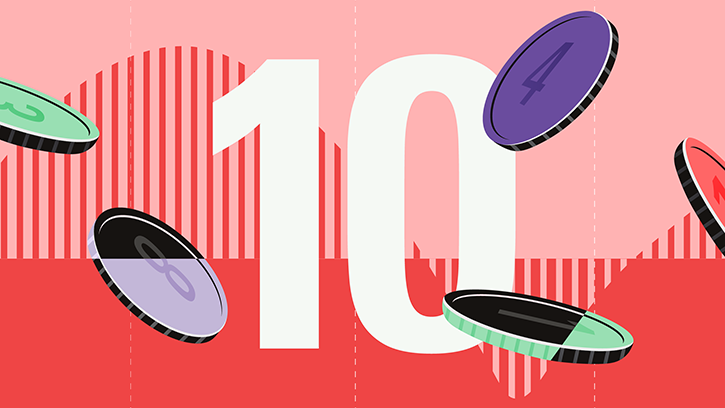
The US economy is cooling off. Inflation is slowing and job openings are rising. Consumers are spending less and borrowing more. While those dynamics might seem worrying at first glance, analysts say they’re signals the economy is moving in the right direction.
Analysts say the combination of falling inflation and a loosening labour market bolsters the Federal Reserve’s confidence for an interest rate cut this year. That would end one of the most aggressive policy-tightening cycles in recent history. Lower rates make borrowing cheaper and tend to be a tailwind for both stocks and consumers.
That tightening cycle helped control inflation and brought supply and demand into better balance after the upheaval of the past few years. The question now is whether the economy can coast to a soft landing or if today’s sustainable slowdown will become tomorrow’s recession.
“Things are slowing, and they’re slowing for the right reasons,” says Sameer Samana, senior global market strategist at the Wells Fargo Investment Institute.
Why a Slowdown Is Good News
Overly hot economic growth is rarely good for financial markets or consumers. “The last couple of years, economic growth has been positive, but profit growth has been basically flat,” Samana explains. Coming out of the pandemic, “growth was so overwhelming and came at a time of such weird supply chain dislocations and labour market scarcity that companies weren’t able to actually generate any profitability off of it”. Consumers suffered too, he says, amid “massive amounts of price inflation”.
Slowing Consumer Spending Weighs on GDP Growth
Much of the slowdown in the economy is attributable to a pullback in consumer spending, according to Brian Rose, senior US economist at UBS Global Wealth Management. He says excess savings from the pandemic have been exhausted and “we’re back to signs of stress, especially among lower-income households”.
Since consumer spending accounts for roughly 70% of US economic activity, this moderation is a major driver of slowing economic growth. GDP growth has fallen from 4.9% in the third quarter of 2023 to 1.4% in the first quarter of this year. While economists expect second-quarter GDP growth to come closer to 2%, according to FactSet, that would still reflect a moderating trend.
“We’ve gone from a period of above-trend growth to below-trend growth,” Rose says. He estimates the economy’s potential growth rate to be about 2%. “The good news here is that below-trend growth helps to relieve inflationary pressure.” That’s exactly what the Fed wants.
That slowdown doesn’t mean trouble for the economy. Many analysts say the weakness is confined to low- and middle-income consumers, and that it points to more bargain-seeking behaviour rather than a total deceleration of spending. “June retail sales surprised to the upside, fitting our view that the US consumer has not checked out,” Bank of America analysts led by US economist Michael Gapen wrote Friday.
Meanwhile, BMO Capital Markets chief US economist Scott Anderson points to record-high household wealth, rising disposable income, and relatively low unemployment as “considerable tailwinds” for consumers. That support “should keep the economy growing at a modest to moderate pace in the months ahead”, he wrote in a note to clients on Friday.
Labour Market Loosening
On the other side of the inflation coin is the labour market, which has softened considerably over the past two years but remains healthy, according to analysts.
Job openings have fallen from roughly 12 million in March of 2022 to about 8 million in May of this year, according to data from the Bureau of Labor Statistics. At the same time, the unemployment rate has risen from a low of 3.4% in December 2022 to 4.1% in June.
In recent testimony to Congress, Fed Chair Jerome Powell described the labour market this way: “Conditions have returned to about where they stood on the eve of the pandemic: strong, but not overheated”. He pointed to how the unemployment rate, while higher than two years ago, is still low from a historical perspective. He says the economy is still creating jobs at a healthy clip, and wage pressures are also easing, helping bring inflation down.
Bank of America’s analysts agree: “The absence of layoffs suggests this is a labour market that is normalizing and not weakening.” This type of labour market is “more or less ‘mission accomplished’ for the Fed”, Rose says, meaning the central bank has “gotten the labour market back into balance without a recession”.
Risks to the Outlook
Both Rose and Samana expect a soft landing, but they acknowledge that risks are skewed to the downside – meaning it’s possible the slowdown could go too far and tip the economy into a recession.
“If the demand for labour keeps weakening, then maybe we’re going to start to see more layoffs and a more rapid increase in the unemployment rate, which the Fed would like to avoid,” Rose says. “Their concern is, if they leave rates too high for too long, then maybe layoffs will start to accelerate and the risks of a hard landing would increase.”
He says another red flag to watch for is a sudden increase in the savings rate. That would indicate a pullback in spending, which could prompt businesses to slow hiring and pave the way for a recession.
Samana adds that a sudden economic slowdown would prompt a different flavour of rate cut – one wherein the Fed realises it’s made a policy mistake by keeping rates too high for too long.




























